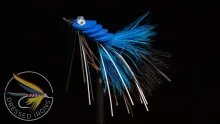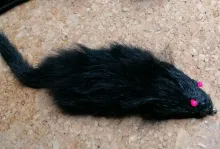A crazy foam construction that looks very little like a mouse and a lot like an opera house
The Sydney Opera Mouse is called that because it faintly resembles Danish architect Utzon's famous landmark in Sidney. Constructed with several arcs of foam, it gets the layered look of the shells that form the roofs on the famous opera building in Sydney Harbor.
It's easy to tie
and doesn't require any special types of foam, just ordinary sheet, which can be bought cheaply in any craft or hobby store. You can of course also use closed cell foam for fly tying, but be warned: you will eat through the small and fairly expensive sheets pretty fast. Spare those for mayflies and extended bodies and opt for the cheap toy stuff, which is firmer and perfect for this purpose.
The only hard part
is to cut the foam shapes that form the body. Three pieces will usually do, and if you follow the general outlines that I have sketched here, you will get a decent result. The shape is like the peel of a quartered orange, but with slightly varying length and width. You can cut it a bit narrower in one end and broader in the other, but it doesn't have to be very precise. Foam is soft and forgiving and can be formed and stretched as you tie.
You need a broad short piece, a medium piece and a narrow long piece. The short one should be as the hook shank, the long one just slightly longer. Add to that a large and light streamer hook, a foam or yarn tail, some strong tying thread, and you have the building materials for a foam mouse.
I have made this mouse
in two versions: one with the largest and broadest foam piece on top, and one with the narrowest one on top, and the latter does look most like a mouse - if you can say at all that it looks like a mouse. That's the one you will get if you use the shapes sketched below and tie them in as shown - short and wide first, then medium and then long and narrow.
Fishing the mouse
Fish this pattern on a floating line and a not too long leader. You can use a wire trace if you are fishing for pike, but honestly - save the energy and the hook, and fish something simpler than this for pike. The fly will be trashed very quickly. A Plipper on a tube is a better choice and even easier to tie.
Thanks to the shape and the light weight, the Sydney Opera Mouse will float, but dive with small splashes when you retrieve it. Swung across a stream or fished against the current it will stay under, which is not the way a mouse swims, so fish it upstream or on still water where it can float freely between your strips.
The fly will undoubtedly do fine as a diver in saltwater or as a diving popper when fishing for bass, so there's lots of possibilities to experiment.
More on mice
- Log in to post comments













Brad,
No, this mo
Brad,
No, this mouse tends to dive if you fish it too fast. A dead drift with a twitch now and then works best. Or you could add a foam lip in the front of the mouse to press it above the surface when it's retrieved.
Martin
Does this mouse plan
Does this mouse plane on the top of the water like other mice patterns? It has been my experience that the more the mouse skitters and skips on the surface the more violent and acrobatic the strike.
I like it Martin. I
I like it Martin. I'm heading up to Northern Ontario in mid-July, gives me a new fly to try. Should work for the smallmouth to. It should work around here, probably in a smaller size for the bass and chain pickerel in the local lakes. I'll let you know how it works.
Jerry
Very simple and inte
Very simple and interesting solution. Thanks Martin.
Miro
Sydney opera mouse
I liked the Sydney opera mouse but it looked like something was missing. I spun three clumps of white deer hair on the hook then trimmed the hair flat on the bottom of the hook,then I tied the foam down at the eye then pulled it over the deer hair and tied the foam down in the back. I tied a narrow piece of leather in the back for a tail. I used 3D craft paint black for eyes,paint brush brissels for whiskers .looks pretty cool can't wait to see how it fishes
Sounds good
David,
That sounds like a pretty good improvement of the pattern. I like simple patterns, but your changes will definitely make the fly more mouse-like. I'd love to see a picture.
Martin